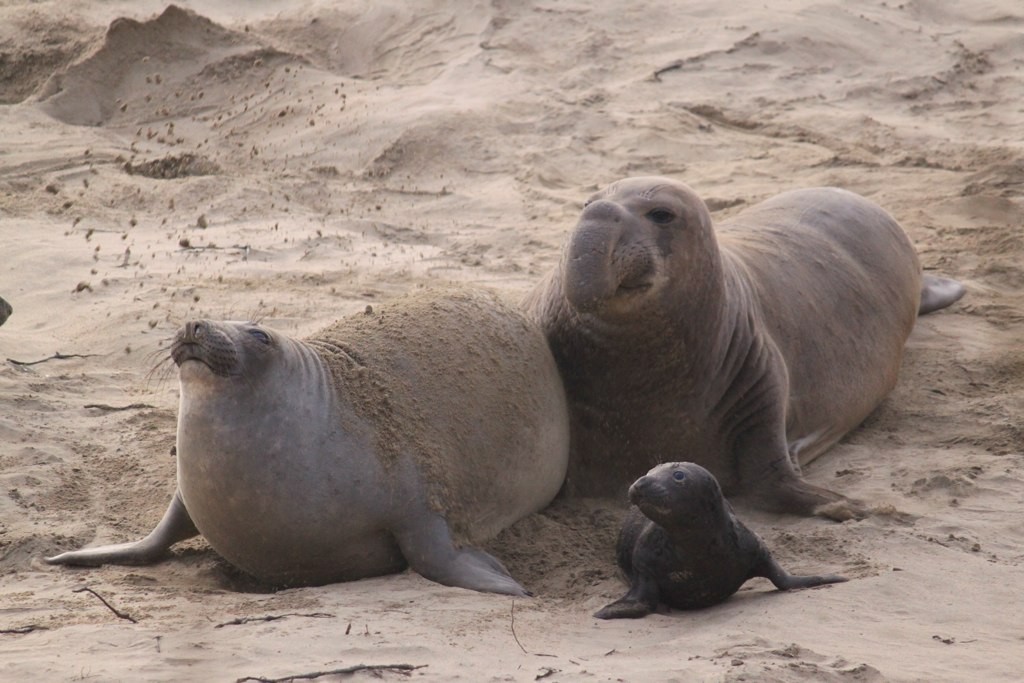Northern elephant seal
A species of Elephant seals Scientific name : Mirounga angustirostris Genus : Elephant seals
Northern elephant seal, A species of Elephant seals
Scientific name: Mirounga angustirostris
Genus: Elephant seals
Content
Description General Info
Description
The huge male northern elephant seal typically weighs 1,500–2,300 kg (3,300–5,100 lb) and measures 4–5 m (13–16 ft), although some males can weigh up to 3,700 kg (8,200 lb). Females are much smaller and can range from 400 to 900 kg (880 to 1,980 lb) in weight, or roughly a third of the male's bulk, and measure from 2.5 to 3.6 m (8.2 to 11.8 ft). The bull southern elephant seals are, on average, larger than those in the northern species, but the females in both are around the same size, indicating the even higher level of sexual dimorphism in the southern species. Northern elephant seals typically live for around 9 years. Both adult and juvenile elephant seals are bar-skinned and black before molting. After molting, they generally have a silver to dark gray coat that fades to brownish-yellow and tan. Adult males have hairless necks and chests speckled with pink, white, and light brown. Pups are mostly black at birth and molt to a silver gray after weaning. The eyes are large, round, and black. The width of the eyes and a high concentration of low-light pigments suggest sight plays an important role in the capture of prey. Like all seals, elephant seals have atrophied hind limbs whose underdeveloped ends form the tail and tail fin. Each of the "feet" can deploy five long, webbed fingers. This agile, dual palm is used to propel water. The pectoral fins are used little while swimming. While their hind limbs are unfit for locomotion on land, elephant seals use their fins as support to propel their bodies. They are able to propel themselves quickly (as fast as 8 km/h) in this way for short-distance travel, to return to water, catch up with a female or chase an intruder. Like other seals, elephant seals' bloodstreams are adapted to the cold in which a mixture of small veins surrounds arteries capturing heat from them. This structure is present in extremities such as the hindlimbs. A unique characteristic of the northern elephant seal is that it has developed the ability to store oxygenated red blood cells within its spleen. In a 2004 study researchers used MRI to observe physiological changes of the spleens of 5 seal pups during simulated dives. By 3 minutes, the spleens on average contracted to a fifth of their original size, indicating a dive-related sympathetic contraction of the spleen. Also, a delay was observed between contraction of the spleen and increased hematocrit within the circulating blood, and attributed to the hepatic sinus. This fluid-filled structure is initially expanded due to the rush of RBC from the spleen and slowly releases the red blood cells into the circulatory system via a muscular vena caval sphincter found on the cranial aspect of the diaphragm. This ability to slowly introduce RBC into the blood stream is likely to prevent any harmful effects caused by a rapid increase in hematocrit. 
General Info
Lifespan
15-20 years
Appearance
Northern elephant seal are massive marine mammals with elongated, barrel-shaped bodies covered in short fur, usually dark to light brown in color. They are known for their exceptionally large noses, especially pronounced in males. Male individuals also possess sizeable chest shields. Females are generally smaller, with more streamlined snouts. Both genders display prominent, inward-curving tusks.
Behavior
Northern elephant seal are primarily aquatic, foraging in ocean environments for various prey, relying mainly on their keen senses and agility. They exhibit social behavior, forming large colonies on land for mating and pupping. Notably, they vocalize using distinctive trumpet-like calls for communication and territory establishment. Males engage in aggressive displays during mating season to secure females and dominate territories.
Population
Increasing
Scientific Classification
Phylum
Chordates Class
Mammals Order
Carnivores Family
Earless seals Genus
Elephant seals Species
Northern elephant seal 